How to choose heating radiators by area: calculating the
Selection of heating radiators by area is a common method of calculating heating devices. Despite the imperfection of the method, it allows to reliably determine the required thermal power of the batteries. We want to figure out how to choose the right radiator by area of the heated room.

Calculation of battery parameters
What does heat loss depend on?
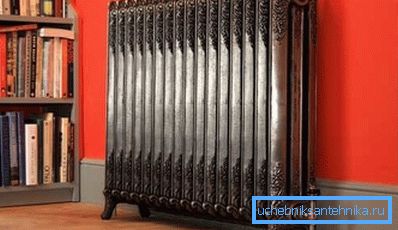
In regions with a pronounced change of seasons, the traditional indicator of coziness and comfort of housing is considered to be its protection from the cold. Therefore, the issue of high-quality and effective heating of the premises is quite acute, especially in recent times.
The fact is that the majority of our compatriots are accustomed to the fact that the intensity of heating should be no less than a certain value, and in case of excess heat you can always open the window and ventilate the room.
Today, such an approach is unacceptable, since the old system is being reorganized in the direction of strict metering of consumed energy, and nobody wants to pay for the temperature increase on the street. Therefore, the consumer wants to know exactly how to calculate the heating radiators over the area of an apartment or house.

The calculation of the required intensity of the work of convectors is aimed at determining the value of the energy that must be transferred to the room to compensate for heat losses occurring through the building envelope:
- window,
- doors,
- walls,
- ceiling,
- floor.
Obviously, the result will depend on such factors:
- The number and size of windows;
- The quality of glass and the number of cameras in them;
- The number and size of doors;
- Temperature regime of the floor above the ceiling;
- Temperature conditions in the space under the floor;
- The degree of wall insulation (a wall with two bricks and a foam layer of 10 cm is considered to be of moderate insulation);
- Orientation of external walls to the cardinal points;
- Wind load on the walls and roof;
- Temperature and climate in the region;
- The number of walls bordering the street;
- The degree of insulation of the ceiling, if there is an unheated attic above it;
- The degree of insulation of the floor, if it is located under the basement or the ground;
- Ceiling height and room size (room volume);
- Heat loss through the ventilation system.

Obviously, a detailed and accurate calculation is a very difficult task, requiring a lot of research and taking into account a huge number of factors. Therefore, to determine the parameters of heating devices, it is customary to use simplified forms of calculations, among which are popular calculations in terms of area, volume, and more accurate formulas with coefficients.
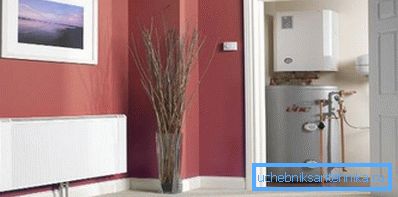
Note! Too many factors affecting the heat loss of the premises make the exact calculation of the required heating intensity difficult, so it is customary to use simplified formulas.
Area calculation
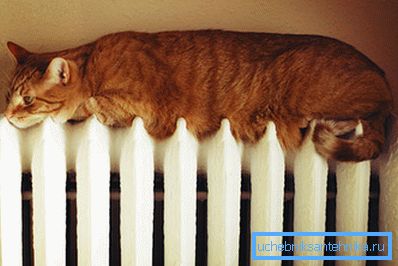
To illustrate the above, let's do a practical calculation. To do this, consider how to calculate the aluminum radiators for the area of the apartment.
According to the norms of SNiP, for heating one square meter of territory with a ceiling height of 2.4 - 2.8 meters, 100 W of thermal energy is required.
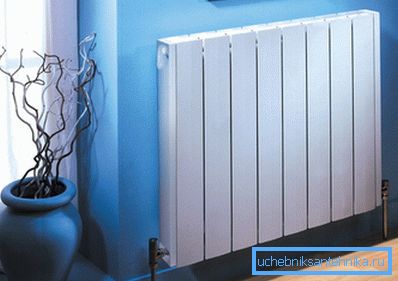
Now we can determine the approximate value of the heat required for heating the entire room:
- Determine the parameters of the room, multiplying its length by the width. Take for example the standard room 3x4 m and get 12 m ?;
- Multiply the value obtained by the normative required heat for heating one square meter of the room - 12x100 = 1200 W.
Note! We determined the total power required to heat our room. These are very approximate data, but acceptable for preliminary calculation.
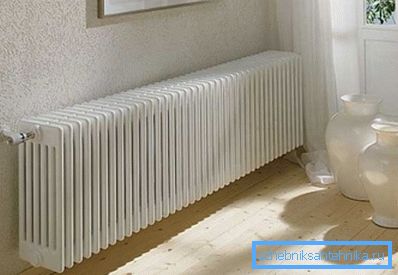
Next, we define the parameters of the heater. We will not determine what area is heated by one section of an aluminum radiator, but simply divide the resulting value of total heat by the heat transfer from one section indicated in the passport of the device.
So let's get started:
- We read the registration certificate of the radiator and see that the heat output of one section is 187 W;
- We divide the value found earlier by the passport - 1200/187 = 6.417;
- We round the result in the direction of a larger integer and get the required number of sections - 7.
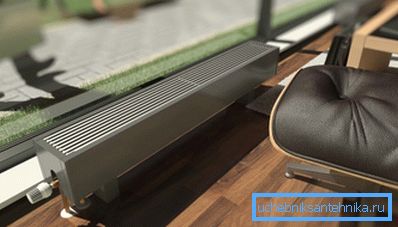
Note! It should be noted that the passport data are indicated for ideal conditions when the coolant is supplied with a normal temperature and pressure. For real conditions, it is recommended to make a correction by 15–20%.
More accurate methods
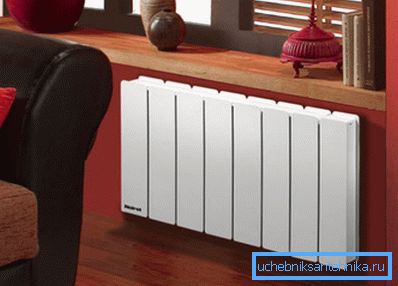
The indicated method is very inaccurate and makes many assumptions:
- ceiling height within 2.8 meters;
- one outer wall;
- one standard window, etc.
However, not all rooms correspond to these parameters, especially in the question of the height of the ceilings.
For apartments with high ceilings, you can use the calculation of the volume. Here we will start from another standard of SNiP, according to which for heating 1 m? rooms require 41 watts of heat (34 watts for walls with insulation and windows with double-glazed windows).
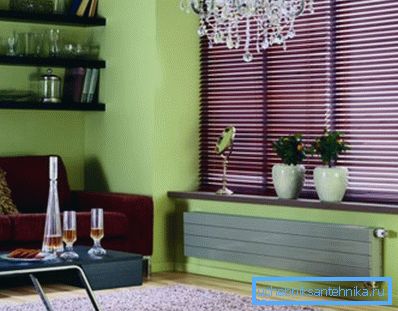
Take our standard room size of 12 m? and imagine that the height of the ceilings is 320 cm. We determine the volume of the room - 3.2х12 = 38.4 m ?.
Now we define the required total heat - 38.4х41 = 1574.4 W. An increase in the height of the ceilings entailed an increase in the required energy by more than 20%.
Next, we act according to the usual scheme - we divide the total value by the heat transfer of one section: 1574.4 / 187 = 8.42. Round up and get the required number of sections - 9.
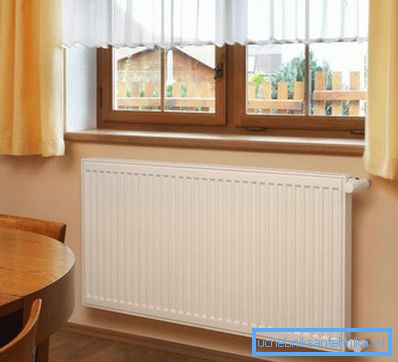
Note! In this example, we were able to make sure that apartments with different ceiling heights require a different number of heater sections.
As we can see, even the calculation by volume does not take into account many factors, such as the size of the windows, features of the walls, the climate of the area.
Therefore, for a more accurate calculation, you will need to take into account these factors. In this case, we use correction factors, and then the formula for the total value will look like this:
Q = 100 W / m? * P * k1 * k2 * k3 * k4 * k5 * k6 * k7, where:
- Q is the total heat required to heat the room;
- P is the area of the room;
- k1 - k7 - correction factors.
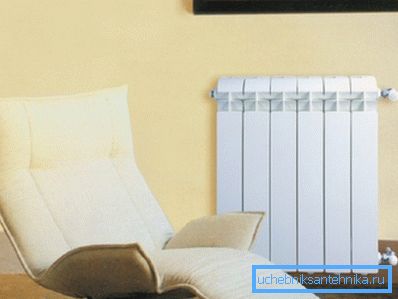
To determine the values of the coefficients use the table:
| Coefficients | Meanings |
| k1 - glazing coefficient | For ordinary double wooden windows - 1.27, for double-glazed windows - 1.0, for triple-glazed windows - 0.85 |
| k2 - wall insulation coefficient | There is no heat insulation (masonry less than 2 bricks) - 1.27, medium insulation (masonry 2 bricks or insulation layer) - 1.0, good thermal insulation (masonry 2 bricks and insulation layer) - 0.85 |
| k3 - the ratio of the size of the windows to the size of the floor | 50% - 1.2, 40% - 1.1, 30% - 1.0, 20% - 0.9, 10% - 0.8 |
| k4 - climate factor | If the temperature of the coldest week of the year is -35? C - 1.5, -25 - 1.3, -20 - 1.1, -15 - 0.9, -10 - 0.7 |
| k5 - coefficient of external walls | One wall - 1.1, two walls - 1.2, three walls - 1.3, four walls - 1.4 |
| k6 - attic coefficient | Cold attic - 1.0, heated attic - 0.9, living room - 0.8 |
| k7 - ceiling height ratio | 2.5 m - 1.0, 3 m - 1.05, 3.5 m - 1.1, 4 m - 1.15, 4.5 m - 1.2 |
Note! After accurate determination of the total value, it should be divided again into the heat transfer of one section and then the required number of sections for this radiator will be obtained.
Conclusion
The price of energy carriers is constantly growing, so an accurate calculation of the intensity of heating determines not only comfort, but also the cost of heating. The video in this article and our instructions will help you not to be mistaken in the calculation of the required values.